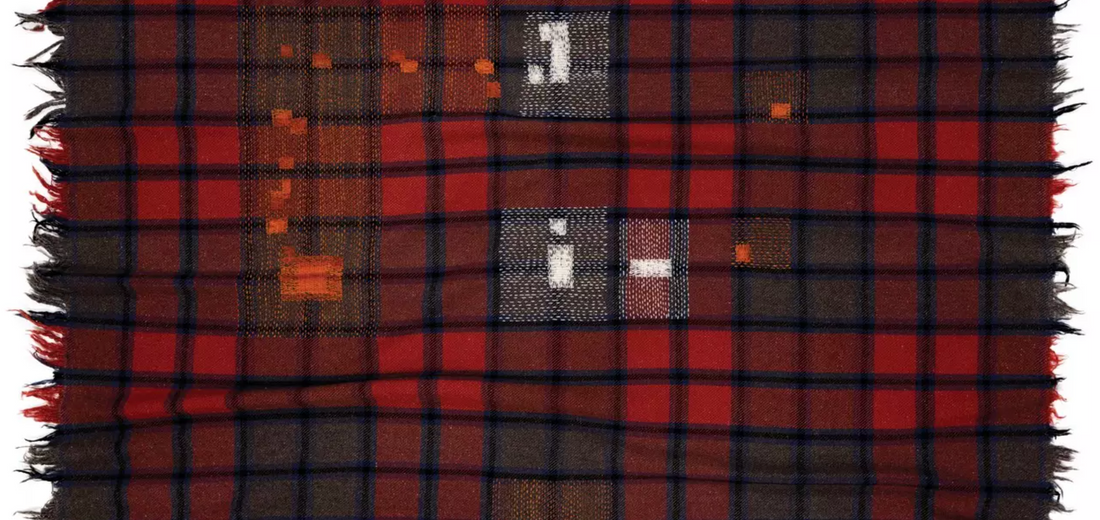
On Mending: Freddie’s Family Rugs, Sixty Years Old, Mended 2022
These red rugs belonged to Freddie Robins’s family. They were used for picnics and outdoor events. You can see them in use in these photographs. Freddie is an artist, Senior Tutor and Reader in Textiles at the Royal College of Art, London. Freddie’s parents were Ronald (Frederick George) Robins and mum Molly (Chisholm) Woolley, becoming Molly (Chisholm) Robins. Freddie says, ‘My Mum was seven years older than my Dad. My Dad was a practical, well-prepared person and loved motoring, so he always had at least one rug in the boot of the car, should it be needed for a picnic in the summer or to keep warm if the car broke down in winter. ‘The car was spotless. It had to be; it was a company car and keeping your car spotless was one of the terms of agreement for having a company car. I wish that I knew where the rugs came from. They may have been a wedding present. My parents married in 1963. If they were wedding presents, then the rugs are nearly 60 years old. I don’t remember them ever being new’. Of the Family Rugs, Freddie says, ‘They always felt so contemporary, compared with the traditional wool blanket. My Mum loved modern things. Probably a reaction to being a teenager during the war’. Of the snapshots, ‘My dad must have been taking the photographs. He was a terrible photographer, but a great father’.

Image above: Freddie's Family Rug, mended, 2022. Image Above Left: Freddie, Molly and Sallie Robins, Dordogne, France, 1983. Below: Sallie and Ronald Robins, France, 1980. Image Above Right: Molly Robins, her sister Peggy and brother-in-law Pip 1980. Below: Willa Coode-Robins, 2004.
After her parents died, Freddie went through their house and found the rugs and these photographs. One rug had holes in it. The damage was a combination of moth holes, a burn and general wear-and-tear at the edges. It’s hard work going through possessions after someone you love has died. The items are so familiar and evocative of your past, but at the same time don’t always fit in the present. Freddie didn’t want to discard the rug, but was uncertain exactly what to do with it. Discussing what colours to mend in, Freddie picked out the orange plastic cool box as a reference. She writes ‘Being the 1970s we had a lot of orange plastic stuff. Maybe 1970s plastic picnic-ware is the way to go, synthetic colours’. ‘This rug is thickly woven wool and the moths have struggled to eat all the way through. Their damage is more like a thinning. When you hold it up to the light, in places you can almost see through it. The burn is a distinctive square hole. Burns often have clear defined edges – suggesting that something really is missing, a proper absence. My intention was to make the mend ‘modern’. Using a combination of orange and white. The mend is intended to be bold and in no way discreet. This should, I hope, become a real picnic rug again in the future’. ‘When I look at all these photographs I realise that the blankets were ever present’, Freddie says. ‘They were silent, useful members of the family’.
From On Mending, Stories of Damage and Repair by Celia Pym. First published in Selvedge issue 109: Rise up.

Image above: Freddie's Family Rug, mended, 2022. Image Above Left: Freddie, Molly and Sallie Robins, Dordogne, France, 1983. Below: Sallie and Ronald Robins, France, 1980. Image Above Right: Molly Robins, her sister Peggy and brother-in-law Pip 1980. Below: Willa Coode-Robins, 2004.
After her parents died, Freddie went through their house and found the rugs and these photographs. One rug had holes in it. The damage was a combination of moth holes, a burn and general wear-and-tear at the edges. It’s hard work going through possessions after someone you love has died. The items are so familiar and evocative of your past, but at the same time don’t always fit in the present. Freddie didn’t want to discard the rug, but was uncertain exactly what to do with it. Discussing what colours to mend in, Freddie picked out the orange plastic cool box as a reference. She writes ‘Being the 1970s we had a lot of orange plastic stuff. Maybe 1970s plastic picnic-ware is the way to go, synthetic colours’. ‘This rug is thickly woven wool and the moths have struggled to eat all the way through. Their damage is more like a thinning. When you hold it up to the light, in places you can almost see through it. The burn is a distinctive square hole. Burns often have clear defined edges – suggesting that something really is missing, a proper absence. My intention was to make the mend ‘modern’. Using a combination of orange and white. The mend is intended to be bold and in no way discreet. This should, I hope, become a real picnic rug again in the future’. ‘When I look at all these photographs I realise that the blankets were ever present’, Freddie says. ‘They were silent, useful members of the family’.
From On Mending, Stories of Damage and Repair by Celia Pym. First published in Selvedge issue 109: Rise up.
